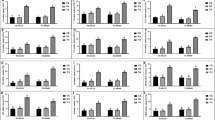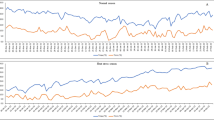Abstract
In plants, stress induces changes in peroxidase enzymes, which play various physiological roles, including involvement in the development of resistance. Experiments were performed at the Elvira major Experimental Station of the NARIC Research Institute for Fruitgrowing and Ornamentals in Érd, Hungary, on two genotypes selected in Hungary (‘Alsószentiváni 117’ and ‘Milotai 10’), on the Californian-bred cultivar ‘Pedro’, and two genotypes bred in Hungary by crossing ‘Pedro’ with the two Hungarian selections: ‘Milotai intenzív’ and ‘Alsószentiváni kései’. These genotypes were chosen on the basis of frost tolerance. Measurements were made on the peroxidase activity and total polyphenol content in the leaves during sprouting (May 2nd, 12th and 20th 2016) and in the uppermost internode of the shoots (November, December 2016; January 2017). Higher peroxidase enzyme activity and polyphenol content in the uppermost internode were good indicators of the frost tolerance of the genotypes and of the stress level to which they were exposed.
Similar content being viewed by others
Avoid common mistakes on your manuscript.
Introduction
The fruit production as part of agriculture faces major challenges to ensure annual production. While the fruit site conditions are more or less stable, the temperature data show a great interannual variability, which is likely the most initiative factors of year effects in phenological phases (Archibald et al. 2009; Hereford et al. 2006; Zaitchik et al. 2007).
Many in situ studies were published about behaviours of pome (Bergamaschi et al. 2008; Chmielewski et al. 2011; Legave et al. 2013; Kunz and Blanke 2016) and stone fruit species (Bergamaschi et al. 2008, Aliman and Drkenda 2009; Kaufmann and Blanke 2017) for variations in temperature during winters and springs, but there were just a handful on how the nut tree species respond to these factors. Warm winters may delay the spring phenology, and the warm springs increased the “speed” of flowering in California (Luedeling and Gassner 2012).
Fu et al. (2015) reported on the declining spring phenology response of trees to the warming springs over the past 30 years. This decline is sensitive, response of the early spring species probably correlates with cooling trend during late winter in western Central Europe (Fu et al. 2014) and the reason for it may be the decreased chilling during the warm years (Fu et al. 2015). Walnut (Juglans regia L.) is a widespread deciduous tree species of great economic importance. According to Vavilov (1951) this walnut species originated in Persia, its primary gene centre. Its native range extends from Iran, northern Turkey, the Carpathian Mountains of Eastern Europe to the Southern Caucasus (Aradhya et al. 2010). Walnuts are very valuable fruit with high energy content (630 kcal/100 g). They are rich in saturated and unsaturated fatty acids, which have a very favourable composition, including a substantial quantity of omega‑3. Walnuts are good sources of vitamin E, folic acid, calcium, magnesium and potassium (Lavardine et al. 1997; Ruggeri et al. 1998) and are also very rich in polyphenolic components (Amaral et al. 2004; Anderson et al. 2001; Fukuda et al. 2003; Pereira et al. 2007). Thanks to the presence of these endogenous compounds, which are important for antioxidant protection, epidemiological analyses detected a correlation between walnut consumption and a decline in deaths caused by heart and circulation diseases (Feldman 2002). Negi et al. (2001) also reported that regular walnut consumption reduced the risk of coronary diseases.
It is generally considered that polyphenolic compounds have a positive effect on human health as they reduce the risk of degenerative diseases, mitigate oxidative stress and inhibit macromolecular oxidation (Silva et al. 2004; Pulido et al. 2000). These compounds are the products of secondary plant metabolism and have strong antioxidant characteristics, thus protecting both plants and their human consumers from stress (Grace and Logan 2000; Haminiuk et al. 2012; Manach et al. 2004; Michalak 2006). One possible response to stress is the neutralisation of reactive oxygen species (ROS) through the activation of enzymatic (superoxide dismutase, peroxidases, catalase, etc.) or non-enzymatic (vitamins C and E, polyphenols, carotenoids, etc.) defence systems (Asada 2006; Mittler 2002). Changes in peroxidase enzymes and phenolic compounds were reported in plants in response to stress (Pereira et al. 2000; Amaral et al. 2004; Cosmulescu and Trandafir 2011). These enzymes are thought to play various physiological roles, for example in the development of resistance (Böddi 2002). Solar et al. (2006) detected a correlation between enhanced polyphenol content in the shoots and infection with Xanthomonas campestris pv. juglandis. The accumulation of phenolic compounds lowered sensitivity to the pathogen. The aim of the present work was to detect possible correlations between the development of cold stress and changes in polyphenol concentration or peroxidase enzyme activity, as these could characterise the physiological and biochemical processes taking place in the plants during various phenophases.
Materials and Methods
Biological Material
The experiments were performed on two varieties selected in Hungary at the Elvira major Station of the Research Institute for Fruitgrowing and Ornamentals, National Agricultural Research and Innovation Centre in Érd: ‘Alsószentiváni 117’ and ‘Milotai 10’, on the ‘Pedro’ variety bred in California, and on genotypes made in Hungary by crossing ‘Pedro’ with the two Hungarian varieties: ‘Milotai intenzív’ (‘Milotai 10’ × ‘Pedro’) and ‘Alsószentiváni kései’ (‘Alsószentiváni 117’ × ‘Pedro’). These genotypes were chosen based on freezing experiments conducted between 2013 and 2015, which allowed them to be classified as frost-sensitive, moderately frost-sensitive or frost-tolerant. ‘Alsószentiváni kései’ proved to be the most frost-tolerant, followed by ‘Alsószentiváni 117’, ‘Milotai 10’, ‘Milotai intenzív’ and ‘Pedro’, which was the most frost-sensitive under Hungarian conditions.
Leaf Sample Preparation
Samples were taken from the uppermost leaves in three replications on three occasions during the sprouting period in May (on May 2nd, 12th and 20th 2016). The freshly picked leaves were ground with quartz sand in liquid nitrogen and a 300 mg/ml solution was prepared using Na phosphate (pH 7.0) buffer. After centrifugation (1300 rpm for 20 min at 10 °C) the clear supernatant was stored at −32 °C until required for analytical measurements.
Shoot Sample Preparation
The upper internodes of shoots were collected in November and December 2016 and January 2017, and the analyses were made in two replications. A 300 mg/10 ml 20% alcohol solution was made from the grated internodes, and this was placed in a UH water bath for 1 h to achieve better dissolution. After centrifugation (1300 rpm for 20 min at 10 °C) the clear supernatant was stored at −32 °C until required for analytical measurements.
Measurement of Peroxidase Enzyme Activity
The peroxidase enzyme activity of the leaves was determined in the presence of H2O2 substrate and ortho-dianisidine chromogenic reagent (ɛ = 11.3) using a spectrophotometer (Hitachi U‑2880A) at λ = 460 nm (Shannoon et al. 1966). The results were given as U/g wet weight.
Determination of Total Polyphenol Content
The polyphenol content of the upper internodes of the shoots was determined spectrophotometrically according to the method of Singleton and Rossi (1965), using Folin-Ciocalteu reagent (Merck 109001) at λ = 760 nm with the help of a calibration curve for gallic acid. The results were given as mM gallic acid equivalent (GAE)/g wet weight.
Results
A comparison of the peroxidase enzyme activity in the upper, youngest leaf samples revealed an increase in this activity from the beginning to the end of May (Fig. 1). The differences between the initial and final values, expressed in round numbers (U/g), were 244 for ‘Alsószentiváni kései’, 166 for ‘Alsószentiváni 117’, 367 for ‘Pedro’, 490 for ‘Milotai 10’ and 430 for ‘Milotai intenzív’, which exhibited a correlation with the resistance of the genotypes to a sudden drop in temperature. The difference in enzyme activity could be attributed to two factors: the aging of the leaves (Sárdi and Stefanovits-Bányai 2006) and the stress effects indicated by the meteorological data (Fig. 2; Pereira et al. 2000). The initial levels of enzyme activity differed for the individual genotypes, with higher values for frost-tolerant varieties and lower values for those sensitive to frost. The differences between the initial and final values were smaller for the resistant varieties and greater for the sensitive ones, indicating their response to cold stress (Sárdi and Stefanovits Bányai 2006). A decline of almost five degrees in the lowest daily temperature was observed between the first and last measuring dates.
It is a well-known fact that the content of polyphenol compounds is closely correlated to the stress tolerance of individual varieties (Melo et al. 2006). The data in Fig. 3 show that the polyphenol content in the upper internodes increased over the months, as the trees prepared for the winter. The differences already observed in the initial values in November for varieties with different levels of frost sensitivity became more pronounced by January. Again, the values recorded for more resistant varieties were higher than those of their sensitive counterparts both in November and January. Here too the increase could be related in part to the aging of the leaves, but was also influenced by the cold stress, to which the sensitive varieties gave a greater response. While a temperature minimum of around −5 °C was characteristic of early November, this dropped to almost −15 °C in January (Fig. 4). A lower polyphenol content was recorded in the frost-sensitive Hungarian varieties, making the buds more likely to suffer frost damage, while ‘Pedro’ was found to have a polyphenol content similar to that of the frost-tolerant varieties. This could be explained by the fact that, having been bred in a warmer climate, this variety responded to cold stress by the overproduction of antioxidant polyphenol compounds, thus allowing the buds to survive the winter months. Therefore, although the polyphenol content was high, the frost resistance of the shoots was similar to that of the frost-sensitive varieties.
Conclusions
In summary, it can be said that the peroxidase enzyme activity in the leaves increased in accordance with the frost sensitivity of the genotypes both as the vegetation period proceeded and in response to the cold stress caused by a decline in temperature. The polyphenols recorded in the shoots during the winter dormancy period also exhibited a rise both over time and parallel to the drop in the external temperature. It could be seen that both the rise in the peroxidase enzyme activity in the leaves and the accumulation of polyphenolic compounds in the uppermost internode could be good indicators of the diverse frost tolerance of varieties and of the stress effects to which they are exposed.
References
Aliman J, Drkenda P (2009) Dynamic of blossoming of autochthonous and introduced cherry genotypes. In: Proceedings of 44th Croatian & 4th International Symposium on Agriculture, Opatija, pp 822–826
Amaral JS, Seabra RM, Andrade PB, Valentão P, Pereira JA, Ferreres F (2004) Phenolic profile in the quality control of walnut (Juglans regia L.) leaves. Food Chem 88:373–379
Anderson KJ, Teuber SS, Gobeille A, Cremin P, Waterhouse AL, Steinberg FM (2001) Walnut polyphenolics inhibit in vitro human plasma and LDL oxidation. Journal Nutrition 131:2837–2842
Aradhya M, Woeste K, Velasco D (2010) Genetic diversity, structure and differentiation in cultivated walnut (Juglans regia L.). Acta Hortic 861:127–132
Archibald SA, Kirton A, Van Der Merwe MR, Scholes RJ, Williams CA, Hanan N (2009) Drivers of inter-annual variability in net ecosystem exchange in a semi-arid savanna ecosystem, South Africa. Biogeosciences 6(2):251–266
Asada K (2006) Production and scavenging of reactive oxygen species in chloroplasts and their functions. Plant Physiol 141(2):391–396
Bergamaschi M, Giovannini D, Liverani A, Sirri S (2008) Influence of climate on flowering phenology of pome and stone fruit in the Emilia Romagna, Italy. In: European Horticulture Congress She, Wien, pp 111–112
Böddi B (2002) Szénhidrát-anyagcsere és légzés [Carbohydrate metabolism and respiration]. In: Láng F (ed) Növényélettan. A növényi anyagcsere, vol 1–2. ELTE Eötvös, Budapest, pp 265–347
Chmielewski FM, Blümel K, Henniges Y, Blanke M, Weber RWS, Zoth M (2011) Phenological models for the beginning of apple blossom in Germany. Meteorol Z 20(5):486–496
Cosmulescu S, Trandafir I (2011) Seasonal variation of total phenols in leaves of walnut (Juglans regia L.). J Med Plants Res 5(19):4938–4942
Feldman EB (2002) The scientific evidence for a beneficial health relationship between walnuts and coronary heart disease. J Nutr 132:1062–1101
Fu Y, Piao S, Beeck MO, Cong N, Zhao H, Zhang Y, Menzel A, Janssens IA (2014) Recent spring phenology shifts in western Central Europe based on multiscale observations. Global Ecol Biogeogr. https://doi.org/10.1111/geb.12210
Fu Y, Zhao H, Piaom S, Peaucelle M, Peng S, Zhou G, Ciais P, Huang M, Menzel A, Penuelas J, Song Y, Vitasse Y, Zeng Z, Janssens IA (2015) Declining global warming effects on the phenology of spring leaf unfolding. Nature 526:104–107. https://doi.org/10.1038/nature15402
Fukuda T, Ito H, Yoshida T (2003) Antioxidative polyphenols from walnuts (Juglans regia L.). Phytochemistry 63:795–801
Grace SC, Logan BA (2000) Energy dissipation and radical scavenging by the plant phenylpropanoid pathway. Philos Trans R Soc Lond 355:1499–1510
Haminiuk CWI, Maciel GM, Plata Oviedo MSV, Peralta RM (2012) Phenolic compounds in fruits—An overview. Int J Food Sci Tech 47:2023–2044
Hereford R, Webb RH, Longpré CI (2006) Precipitation history and ecosystem response to multidecadal precipitation variability in the Mojave Desert region, 1893–2001. J Arid Environ 67:13–34
Kaufmann H, Blanke MM (2017) Performance of three numeric models to assess chilling—A case study with cherry for Germany. Reg Environ Change 17:1–9
Kunz A, Blanke MM (2016) Effects of climate change on fruit tree physiology—Based on 55 years of meteorological and phonological records at Klein-Altendorf. Acta Hortic 1130:49–54. https://doi.org/10.17660/ActaHortic.2016.1130.7
Lavedrine F, Ravel A, Poupard A, Alary J (1997) Effect of geographic origin, variety and storage on tocopherol concentrations in walnuts by HPLC. Food Chem 58(1-2):135–140
Legave JM, Blanke MM, Christique D, Giovannini D, Matthieu V, Oger R (2013) A comprehensive overview of the spatial and temporal variability of apple bud dormancy release and blooming phenology in Western Europe. Int J Biometeorol 57:317–331
Luedeling E, Gassner A (2012) Partial least squares regression for analyzing walnut phenology in California. Agric For Meteorol 158:43–52
Manach C, Scalbert A, Morand C, Remesy C, Jimenez L (2004) Polyphenols: food sources and bioavailability. Am J Clin Nutr 79:727–747
Melo GA, Shimizu MM, Mazzafera P (2006) Polyphenoloxidase activity in coffee leaves and its role in resistance against the coffee leaf miner and coffee leaf rust. Phytochemistry 67:277–285
Michalak A (2006) Phenolic compounds and their antioxidant activity in plants growing under heavy metal stress. Pol J Environ Stud 15:523–530
Mittler R (2002) Oxidative stress, antioxidants and stress tolerance. Trends Plant Sci 7(9):405–410
Negi AS, Luqman S, Srivastava S, Krishna V, Gupta N, Darokar MP (2001) Antiproliferative and antioxidant activities of Juglans regia fruit extracts. Pharm Biol 49(6):669–673
Pereira JA, Oliveira I, Sousa A, Valentão P, Andrande PB, Ferreira ICFR, Ferreres F, Bento A, Seabra R, Estevinho L (2007) Walnut (Juglans regia L.) leaves: Phenolic compounds, antibacterial activity and antioxidant potential of different cultivars. Food Chem Toxicol 45:2287–2295
Pereira LF, Goodwin PH, Erickson LE (2000) Peroxidase activity during susceptible and resistant interactions between cassava (Manihot esculenta) and Xanthomonas axonopodis pv. manihotis and Xanthomonas cassava. J Phytopathol 148:575–577
Pulido R, Bravo L, Saura Calixto F (2000) Antioxidant activity of dietary polyphenols as determined by a modified ferric reducing/antioxidant power assay. J Agric Food Chem 48:3396–3402
Ruggeri S, Cappelloni M, Gambelli L, Nicoli S, Carnovale E (1998) Chemical composition and nutritive value of nuts grown in Italy. Ital J Food Sci 10(3):243–252
Sárdi É, Stefanovits Bányai É (2006) Relationship between peroxidase activity and the amount of fully N‑methylated compounds in bean plants infected by Pseudomonas savastanoi pv. phaseolica. Acta Physiol Plant 28(2):95–100
Shannoon LM, Kay E, Lew JW (1966) Peroxidase Isozymes from horseradish roots. J Biol Chem 241(9):2166–2172
Silva BM, Andrade PB, Valentão P, Ferreres F, Seabra RM, Ferreira MA (2004) Quince (Cydonia oblonga Miller) fruit (pulp, peel, and seed) and jam: antioxidant activity. J Agric Food Chem 52:4705–4712
Singleton VL, Rossi JA (1965) Colorimetry of total phenolics with phosphomolybdic-phosphotungstic acid reagents. Am J Enol Viticult 16:144–158
Solar A, Colarič M, Usenik V, Stampar F (2006) Seasonal variations of selected flavonoids, phenolic acids and quinones in annual shoots of common walnut (Juglans regia L.). Plant Sci 170:453–461
Vavilov NI (1951) The origin, variation, immunity and breeding of cultivated plants 31–34. In: Verdoon F (ed) Chronica botanica, an international collection of studies in method and history of biology and agriculture, vol 13, p 366
Zaitchik BF, Evans JP, Geerken RA, Smith RB (2007) Climate and vegetation in the Middle East: inter-annual variability and drought feedbacks. J Climate 20:3924–3941
Acknowledgements
This research was funded by the National Research, Development and Innovation Office in the framework of the project entitled: “Walnut breeding in order to release new late leafing and lateral bearing cultivar(s) (Project No. 123311)”.
Funding
Open access funding provided by Hungarian University of Agriculture and Life Sciences.
Author information
Authors and Affiliations
Corresponding author
Ethics declarations
Conflict of interest
K.S. Bartha, G. Bujdosó and É. Stefanovits-Bányai declare that they have no competing interests.
Rights and permissions
Open Access This article is licensed under a Creative Commons Attribution 4.0 International License, which permits use, sharing, adaptation, distribution and reproduction in any medium or format, as long as you give appropriate credit to the original author(s) and the source, provide a link to the Creative Commons licence, and indicate if changes were made. The images or other third party material in this article are included in the article’s Creative Commons licence, unless indicated otherwise in a credit line to the material. If material is not included in the article’s Creative Commons licence and your intended use is not permitted by statutory regulation or exceeds the permitted use, you will need to obtain permission directly from the copyright holder. To view a copy of this licence, visit http://creativecommons.org/licenses/by/4.0/.
About this article
Cite this article
Bartha, K.S., Bujdosó, G. & Stefanovits-Bányai, É. Biochemical Methods for the Characterisation of Walnut Genotypes with Different Levels of Frost Tolerance. Erwerbs-Obstbau 65, 293–298 (2023). https://doi.org/10.1007/s10341-022-00823-2
Received:
Accepted:
Published:
Issue Date:
DOI: https://doi.org/10.1007/s10341-022-00823-2








